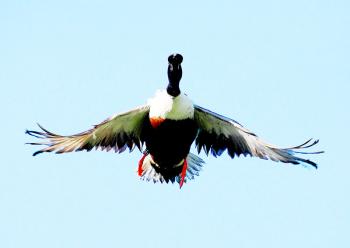
This year's fall flight will see more adult birds as low pond counts this spring, along with drought conditions, will impact production. (Submitted Photo/Courtesy of John K. Flores)
U.S. Fish and Wildlife report will reveal low productivity
For years and years around the 4th of July, duck hunters would wait with baited breath for the U.S. Fish and Wildlife Service’s annual Waterfowl Breeding Population and Habitat Survey Report. This is like getting those Christmas in July sales ads.
You expect them. You read them. You may or may not shop and buy. But, it’s part of the norm year after year.
Nothing is normal with the U.S. Fish and Wildlife Service these days. Nor is it normal for the Louisiana Department of Wildlife and Fisheries.
For one thing, we already know what our duck season dates and bag limits are for the upcoming season. In years past, we wouldn’t typically know until after the August Louisiana Wildlife Commission meeting what weekend duck season would open.
There was always sort of a mad rush up and down the Mississippi Flyway for seasons to be set on time. In some of the northern states, sometimes that meant a court order to get seasons underway.
Now, all states in the flyway are in lockstep, where seasons will be set in the winter for the following year and ratified in the spring. That sounds like a good thing, and honestly, it is.
However, after doing things the same way as far back as anyone can remember, it seems a bit strange this year not to have duck hunters talking about the breeding population survey here in the third week of July. It would be like doing away with Christmas in July sales ads.
“This was the sequence of events for years and years — right? The Feds would release the duck pond count and breeding pair numbers around the Fourth of July, and three days later, you got a Mack’s Prairie Wings catalog in the mail and everything was good,” said John Devney, Delta Waterfowl Vice President of U.S. Policy. “We’re operating under a totally new set of rules, and everybody has got to get used to them.”
Devney said as a result of no report coming from the U.S. Fish and Wildlife Service, conservation agencies such as Delta Waterfowl have had to make news out of air, Devney said. What’s more, hunters are starved for news.
“It’s amazing,” Devney said. “Everybody is so hungry for it. We’re making news about air because as we know, every duck hunter is anxious to know what’s happening on the prairie.”
So what do we know about the breeding grounds ahead of the U.S. Fish and Wildlife Service’s official report that is expected to be released sometime in August?
In a July 13 Delta Waterfowl press release, Frank Rohwer, Delta Waterfowl President and Chief Scientist, said the good news is we have a lot of ducks because of strong duck production the past several years. The bad news is those ducks found dry conditions across much of their key breeding areas this spring.
Because of the new U.S. Fish and Wildlife Service rule-setting format, the 2016-17 Louisiana duck season once again will be a 60-day, six-bird liberal season for an unprecedented 22 straight years.
But, those numbers were based partially on the 2015 U.S. Fish and Wildlife Service Survey Report. Therefore, any impact of the drought-like conditions that are currently on the prairie won’t have an impact on rules until next year.
“We haven’t seen a below average pond count in a long time,” Rohwer said. “I think we could decline from last year’s count of 6.3 million to fewer than 4 million, which we haven’t seen since 2003. Dry conditions almost certainly led to a lower initial nesting effort, a substantially reduced re-nesting effort and lower duckling survival in many areas of the breeding grounds.
“May and June rains in parts of Alberta, Saskatchewan, and North Dakota probably helped in some local areas, but not enough to offset the overwhelming dry conditions when the ducks returned this spring,” Rohwer added.
What most prognosticators are saying up and down the Mississippi Flyway is though duck production will be lower this year due to far less pond numbers and drought conditions, the fall flight still should be above the long-term average.
However, the fall flight will contain a larger number of adult birds and fewer juveniles.
In seven weeks, Louisiana duck hunters will get a little taste of what this year’s duck numbers will look like when the September early teal season gets underway. Conventional wisdom says blue-winged teal numbers have been at such record highs the past couple years that even if down a million or so, they’ll still be far above the long-term population when they get here.
Only time will tell what the 2016-17 season will actually look like. But, with no official U.S. Fish and Wildlife Service Waterfowl Breeding Population and Habitat Survey Report, right now all prognosticating is just air. …
EDITOR’S NOTE: Flores is The Daily Review’s Outdoor Writer. If you wish to make a comment or have an anecdote, recipe or story to share, contact Flores at 985-395-5586, at gowiththeflo@cox.net or visit his Facebook page, Gowiththeflo Outdoors.
- Log in to post comments
